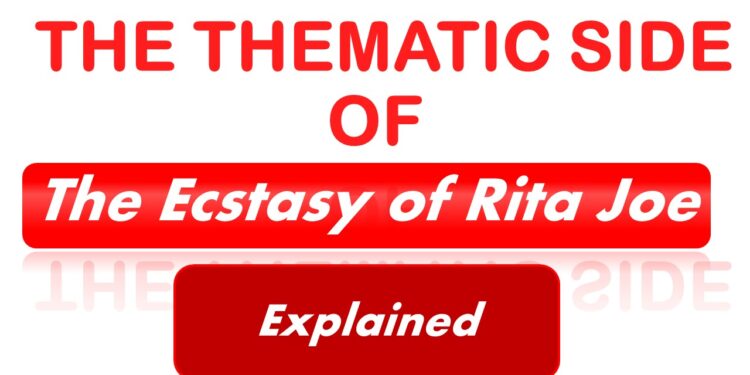Comment on the thematic side of The Ecstasy of Rita Joe
George Ryga’s classic novel, The Ecstasy of Rita Joe, explores themes that are relevant to the complexity of Indigenous identity, cultural conflict, and the enduring spirit of resilience in a way that is both poignant and moving. Since its 1967 premiere, the play has examined systemic injustices, the effects of cultural displacement, and the struggles faced by Indigenous communities in Canada.
Indigenous Identity:
- Cultural Displacement:
- The central theme of “The Ecstasy of Rita Joe” is cultural displacement, which depicts the struggle of Indigenous people, such as Rita Joe, to feel accepted in a society that frequently marginalizes and alienates them. The drama explores the difficulties of adjusting to a society that thrusts its standards, laws, and customs upon a people who have strong ties to the land and traditional ways of life.
- Loss of Language and Tradition:
- Rita Joe’s journey, as a symbol of the erosion of Indigenous languages and traditions, is explored in depth in this play. Rita is a representative of the larger experience of Indigenous people who were taken against their will and separated from their cultural heritage because she attended a residential school as a child. The demise of customs and language serves as a moving metaphor for the wider effects of colonial policies on Indigenous people.
- Identity Struggles:
- The character of Rita Joe grapples with profound identity struggles as she attempts to reconcile her Indigenous heritage with the expectations and judgments imposed by the dominant society. The play reflects the internal conflict faced by many Indigenous individuals who must navigate between two worlds, often experiencing a sense of alienation and a fractured sense of self.
Also Read-
Cultural Clash:
- Clash of Worldviews:
- “The Ecstasy of Rita Joe” delves into the conflicting worldviews of the dominant Western culture and Indigenous cultures. The play eloquently captures the clash between the exploitative and individualistic values of the dominant society and the traditional Indigenous values, which are based on a close connection to nature and communal harmony. Rita Joe and her community experience tension and conflict as a result of this clash.
- Judgment and Stereotyping:
- The play exposes the pervasive issue of judgment and stereotyping faced by Indigenous individuals. Rita Joe, as a representative figure, confronts prejudiced attitudes and racial stereotypes that contribute to her marginalization and limit her opportunities for societal integration. The play serves as a powerful critique of the systemic racism embedded in Canadian society.
- Institutional Oppression:
- Ryga’s work delves into the institutional oppression faced by Indigenous communities, particularly through the character of Rita Joe’s interactions with the legal and justice systems. The play sheds light on the inherent biases within these systems, which perpetuate cycles of poverty and despair, further exacerbating the challenges faced by Indigenous individuals.
Resilience and Survival:
- Indomitable Spirit:
- “The Ecstasy of Rita Joe” pays tribute to the unwavering resilience of Indigenous communities in spite of the tragedies and injustices they portray. Rita Joe is a living example of this perseverance because she fights to maintain her identity, dignity, and hope in the face of unfathomable adversity. The play turns into a monument to the resilience of the human spirit against institutionalized oppression.
- Community Solidarity:
- The sense of community solidarity is a recurring theme, emphasizing the importance of collective strength in the face of adversity. Rita Joe’s community, despite facing challenges, comes together to support one another and resist the forces that seek to dismantle their way of life. The communal bonds portrayed in the play highlight the potential for resilience and resistance within Indigenous communities.
- Cultural Revitalization:
- “The Ecstasy of Rita Joe” suggests the possibility of cultural revitalization and reclaiming Indigenous identity. Despite the attempts at assimilation, the play hints at the resilience of Indigenous cultures as they seek to revive and preserve their languages, traditions, and spiritual practices. This theme reflects a broader movement of cultural resurgence within Indigenous communities.
Conclusion
George Ryga’s The Ecstasy of Rita Joe is a potent and complex examination of themes that profoundly connect with the struggles that Canada’s Indigenous communities face. The play explores the deep conflicts surrounding Indigenous identity, the collision of cultural worldviews, and the incredible resiliency that endures in the face of systematic oppression. Ryga creates a story that celebrates the resilient spirit of Indigenous peoples and acts as a critique of both historical and modern injustices through the persona of Rita Joe and her community.

“The Ecstasy of Rita Joe” remains a relevant and impactful work that invites audiences to reflect on the historical legacy of colonization, the ongoing challenges faced by Indigenous communities, and the possibilities for cultural resurgence and healing. The play’s themes continue to resonate in the broader discourse on Indigenous rights, reconciliation, and the importance of preserving and celebrating diverse cultural identities within the fabric of Canadian society.
FAQ.
1. What is “The Ecstasy of Rita Joe” about?
“The Ecstasy of Rita Joe” is a play written by George Ryga that explores the struggles of Rita Joe, an Indigenous woman, as she navigates the challenges of cultural displacement, clashes with the dominant Western society, and strives for resilience and identity in the face of systemic oppression.
2. How does the play address the theme of Indigenous identity?
The play addresses Indigenous identity by portraying Rita Joe’s struggles with cultural displacement, loss of language and tradition, and internal conflicts as she attempts to reconcile her Indigenous heritage with the expectations of the dominant society. It reflects broader issues faced by Indigenous individuals in asserting their identity.
3. What cultural clash themes are depicted in “The Ecstasy of Rita Joe”?
The play depicts a clash of worldviews between Indigenous cultures and the dominant Western culture. It explores the collision of traditional Indigenous values with the individualistic and exploitative values of the dominant society. The themes include judgment, stereotyping, and institutional oppression faced by Indigenous communities.
4. How does the play highlight the resilience of Indigenous communities?
“The Ecstasy of Rita Joe” celebrates the resilience of Indigenous communities through the character of Rita Joe and the collective strength of her community. Despite facing hardships and systemic oppression, the play portrays the indomitable spirit of resilience within Indigenous communities, emphasizing communal bonds and cultural revitalization.
5. What specific injustices are critiqued in the play?
The play critiques various injustices, including cultural displacement due to residential schools, the loss of language and tradition, racial stereotyping, and institutional oppression within legal and justice systems. It offers a comprehensive critique of systemic racism and biases embedded in Canadian society.
6. How does the play address the theme of community solidarity?
Community solidarity is a recurring theme in the play, highlighting the importance of collective strength within Indigenous communities. Rita Joe’s community comes together to support each other, resist external forces, and maintain a sense of solidarity in the face of societal challenges.














